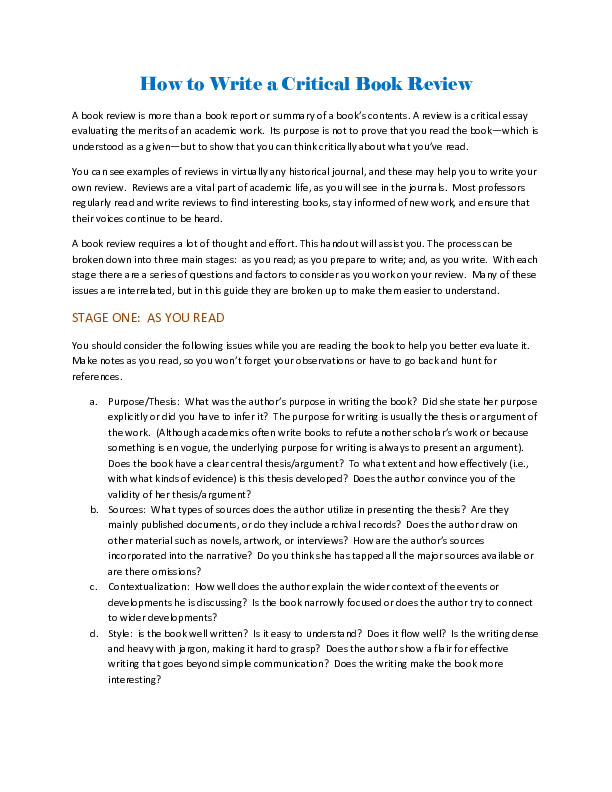The art of a critical book review transcends mere summarization; it invites a panoramic view of the text, granting readers an opportunity to embark on an intellectual journey. At its core, a critical book review endeavors to dissect a book’s thematic essence, probes the structural nuances, and offers a perspective that provokes contemplation and dialogue. Through this lens, a critical review is not a mere critique, but a tantalizing invitation into an author’s psyche and the contextual labyrinth that frames their narrative.
To embark on crafting a critical book review, one must first cultivate an acute awareness of the book’s subjectivity. This begins with an immersive reading experience. In the pursuit of understanding the author’s underlying motivations, pay heed to the subtleties nestled within the pages. This is where the reviewer must don the hat of an investigator. What is the overarching theme? What are the author’s intentions? What philosophical or sociopolitical threads weave through the discourse? These initial inquiries lay the groundwork for a robust analysis.
Once the foundational understanding is established, it becomes imperative to dissect the book’s structure. An author’s stylistic choices often serve as a vessel for their message. Delve into aspects such as pacing, narrative style, and character development. Does the author employ an omniscient point of view, or is it cloistered within a first-person anecdote? These choices breathe life into the book, influencing how the story unfolds and how readers engage with it emotionally. A riveting narrative can elevate even the most mundane subjects, while a lackluster delivery can diminish even the most profound themes.
While examining the text, consider the linguistic artistry—how words serve as brush strokes on the canvas of literature. The potency of metaphor, the rhythm of sentences, and even the choice of vocabulary can reflect the author’s intent and emotional resonance. Does the prose whisper or shout? Is it introspective or exuberant? Such inquiries lead to richer insights and fuel a more comprehensive critique.
Transitioning from observation to evaluation involves juxtaposing the author’s stylistic elements against the thematic tapestry. This analysis must transcend personal biases; it requires an objective lens grounded in critical theory. Familiarize yourself with theoretical frameworks that could enhance your discussion—feminist theory, post-colonialism, or existentialism. Each lens allows for a multifaceted examination, revealing dimensions that may otherwise remain obscured. By bridging the text with broader intellectual traditions, the review transforms into a dialogue with the discourse itself.
In addition to evaluating the text, it is crucial to position the work within its literary canon. Understanding where the book stands among its peers illuminates its significance. Is it groundbreaking? Does it adhere to established tropes, or does it subvert them? Comparing and contrasting the work with others in the genre or by the same author unveils the contribution to literary conversations. This contextualization fosters a deeper appreciation and prompts readers to ponder not just the specific work, but its role within a broader narrative landscape.
Furthermore, it is vital to acknowledge the audience’s expectations. Each reader approaches a text with a myriad of preconceived notions shaped by experiences, education, and cultural background. Gauge the anticipated readership—what do they seek? A critical review that articulates the target demographic can enhance its relevance, enticing readers who share similar interests or challenges in engaging with the text. By elucidating how the book resonates with or diverges from its intended audience, the review cements its utility.
Once the analysis has reached its zenith, it is time to distill the discernments into a cogent assessment. This section functions as the culmination of your insights—engaging yet succinct. Articulate your findings with clarity, employing judicious supporting examples from the text. Isn’t it enthralling when a distilled idea resonates profoundly? Challenge the reader to ponder the larger implications of the work: what does it reveal about human nature? Society? The zeitgeist? Pose questions that invite further exploration and ignite imaginations.
Closing the review demands finesse; it should echo the opening, offering a harmonious conclusion that lingers in the reader’s mind. Reflect on how the book altered your perception, beckoning readers to embark on their own journey through its pages. An effective conclusion should not merely summarize but invite readers to engage with the text, stoking their curiosity and fostering an eagerness to discuss the work. Consider leaving them with a compelling quote from the book or a provocative question that encapsulates your evaluation.
In essence, a critical book review operates on multiple levels, functioning as a bridge between the reader and the text, as well as between the author’s intentions and the audience’s interpretations. It beckons the adventurous spirit of inquiry, encourages a diligent dissection of themes and styles, and ultimately ushers forth a narrative ripe for exploration. With these elements harmoniously intertwined, your review can not only reflect a passionate engagement with literature but also serve as a guiding light for fellow bibliophiles seeking new realms of understanding. So gather your thoughts, sharpen your pencil, and embark on the exhilarating journey that is writing a critical book review. The world awaits your insights!
